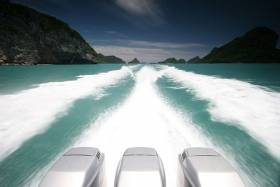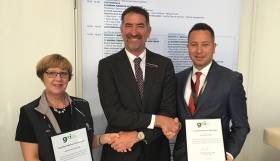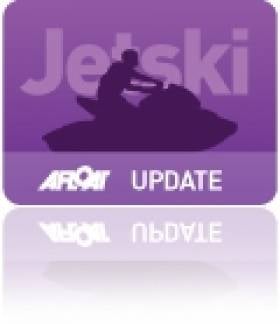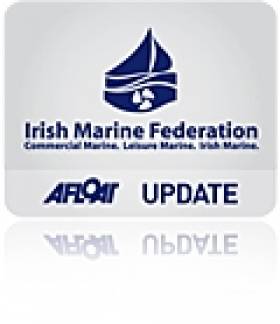Displaying items by tag: ICOMIA
'Nautical Tourism' is New Focus for ICOMIA & European Boating Industry in Partnership to Develop Global Boating Industry
European Boating Industry (EBI) and ICOMIA have entered a new partnership with mutual benefits for both EBI and ICOMIA members and an increased focus on the further development of nautical tourism.
European Boating Industry (EBI) represents the European recreational boating industry. It encompasses all sectors relating to boating such as boatbuilding, equipment manufacturing, marinas, charter companies, and service providers. EBI is an established stakeholder at EU level, promoting the interests of its members through day-to-day advocacy on key issues ranging from the Recreational Craft Directive, Blue Economy, the European Green Deal, Research and Innovation, and fiscal framework, to qualifications, tourism, and trade policy. It is in constant exchange with the European Commission, European Parliament, Council, and stakeholders to bring across the key messages of the industry.
ICOMIA is an international association, whose full members are global marine industry associations. ICOMIA is a longstanding stakeholder in the various relevant working groups of the European Commission and employs technical and environmental specialists who are engaged in EU-related work. Its mission is to act as the voice of the recreational marine industry worldwide to facilitate, influence, inform and research.
Through this agreement, ICOMIA will continue to provide technical and environmental support and ensure cohesive representation of and communication with EBI and ICOMIA members. ICOMIA will assist with statistical work or studies, including the annual ICOMIA Statistics Book.
As part of this new partnership, EBI will start providing bi-monthly monitoring newsletters, which will include updates on EU work and EBI’s advocacy activities to keep its global partner updated.
The agreement was signed by the Presidents of the two associations, Sara Anghel and Jean-Pierre Goudant, as well as their respective Secretary-Generals, Udo Kleinitz and Philip Easthill.
Udo Kleinitz, Secretary-General of ICOMIA, said: “EBI and ICOMIA have a high overlap in their European membership. From the outset we have been working on complementing each other’s work rather than duplicating. This agreement is a step to implement better exchange of information and joint action. I believe I can speak for ICOMIA and its members in saying we are very pleased about the public message it sends in demonstrating our stronger ties.”
Philip Easthill, Secretary-General of EBI, said: “We are delighted to have signed the renewed and extended partnership agreement with ICOMIA. It allows for optimal communication channels and cooperation between the work of EBI at EU level and ICOMIA’s global activities. We have agreed a partnership that supports both associations’ members and the entire recreational boating industry to create suitable regulatory conditions.”
ICOMIA Brief Boat Builders & Engine Manufacturers on New Recreational Craft Directive
The International Council of Marine Industry Associations (ICOMIA) are advising boat builders and engine manufacturers to check their national trade and distribution channels before interpreting the phrasing within the new Recreational Craft Directive (RCD) relating to engines and components placed on the market that are certified to the old RCD.
The Irish Marine Federation is a member of ICOMIA's International Council.
On 18 January 2017, after a year long transitional period where both old and new Directives have been applicable, the new RCD (2013/53/EU) concerning recreational craft and personal watercraft will become fully applicable meaning marine engines, components and craft certified according to the old RCD (94/25/EC as amended by 2003/44/EC) may no longer be placed on the European market.
After consultation with their members, ICOMIA and IMEC were made aware that boat builders and engine manufacturers were unclear about what the term ‘placed on the market’ exactly meant, and whether watercraft, marine engines and components that were in compliance with the old RCD and ‘placed on the market’ before 18 January would comply with the new RCD after that date.
This issue is addressed within Article 55 of the new RCD, which deals with the transitional period, stating that ‘Member States shall not impede the making available on the market or the putting into service of products covered by Directive 94/25/EC which are in conformity with that Directive and which were placed on the market or put into service before 18 January 2017.’
This means watercraft built to be certified and placed on the market under the new RCD may be fitted with:
• Engines and components certified to the old RCD placed on the market before 18 January 2017
• Engines and components certified according to new RCD • Any combination of the two The European Commission and Market Surveillance Authorities have confirmed the Article 55 guidance is clear.
Nevertheless, ICOMIA is aware that available interpretation may disregard all facets of product import and distribution and that many boat builders are unclear on how to interpret Article 55. “The key message is not to make any assumptions about what ‘placed on the market’ implies” explains Patrick Hemp, ICOMIA Technical Consultant. “Should a manufacturer have any product still in stock that may be deemed not placed on the market, it is important to engage with the EU Member States likely to be involved in trade and customs and clarify the processes as early as possible before 18 January 2017”.
For more help understanding and complying with the RCD, ICOMIA and European Boating Industry have released a revised version of their invaluable ‘Guide to the new RCD’ which is available as an Apple or Android app or pdf file. The Guide covers, in detailed chapters, full information on the new legal framework, the main changes in the essential safety and environmental requirements, the conformity assessment procedures for certification and CE-marking as well as special cases.
First Ever Female Certified Marina Professional Awarded
The ICOMIA World Marinas Conference in Amsterdam (17-19 November 2016) provided the ideal backdrop for the presentation of the latest two Global Marina Institute (GMI) certificates.
Michelle Hitchcock, Head of Business Development at MDL Marinas Ltd, was awarded the Certified Marina Professional (CMP) certificate. Michelle is the first woman in the world to be accredited as a CMP, since its inception in 2012.
Designed to recognise the skills and experience of those working in the marina sector, but not directly managing marinas, Michelle is the perfect candidate to receive this accolade. She has worked at MDL Marinas Ltd since 1999 in a variety of roles but is now Head of Business Development.
Working at one of Europe’s leading marina groups, she is responsible for the company’s training development and delivery, the monitoring of customer service and quality and overseeing all operational aspects of business systems throughout the group’s 100+ marinas located across the UK, France, Italy and Spain.
Upon receiving her certification, Micelle Hitchcock commented: “I am honoured and proud to be awarded my CMP accreditation by the GMI. This is a major highlight of my career, made more special as the presentation was in front of an audience of my peers at the ICOMIA World Marinas Conference.”
Can Akaltan was also presented with his Certified Marina Manager (CMM) certificate during the Conference. Can is General Manager at Cesme Marina in Izmir, Turkey. Building on his successful career as a yacht captain, he joined Cesme Marina as the Marina Manager and has since been promoted to the position of General Manager.
Can Akaltan also remarked: “I feel privileged to be awarded the only internationally recognised certificate in the marina industry for marina professionals. It is also a great pleasure to become part of a very special group of industry pioneers.”
John Hogan, Chairman of the GMI, added: “It is good to have our first female CMP, particularly as she is from Europe, to add to those marina professionals already certified in Australia and Asia. I am hopeful that Michelle will pave the way for others who work in the industry to look to CMP as a way of developing and recognising their talents. It is also good to see another CMM recognised in Turkey.”
Today the GMI has awarded 130 active CMMs and CMPs across the globe and looks to continue this growth into 2017.
British Marine contributes to this by running a series of GMI marina management courses in locations across the UK and Europe.
Ideas for Jetski Use Launched on New 'Ride the Wave Right' Website
#JETSKI – The International Council of Marine Industry Associations (ICOMIA) has launched its new global personal watercraft resource website which is intended for PWC riders.
Working in collaboration with personal watercraft manufacturers Kawasaki, Yamaha and BRP, ICOMIA's 'Ride the Wave Right' website, which is available in English, French and German, provides advice for safe and responsible PWC riding, information on the history and evolution of PWC, as well as ideas for recreational PWC activities and tips on how to be environmentally friendly on the water. The website ensures that PWC enthusiasts and government authorities have access to policy and legislation information on CE Products, (the markings and documentation which EU directives require products to carry before being placed on the market), the CIN Checker Database (on-line Craft Identification Number (CIN) checking system) and Grey Imports (PWCs that are not purchased through official dealers in your home country). The website also features links to product and manufacturer information directly from the Kawasaki, Yamaha and BRP websites.
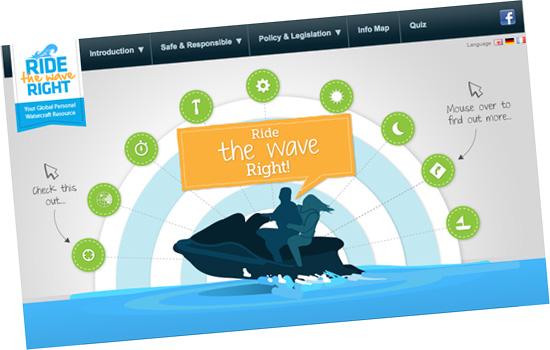
In addition, an interactive world map provides essential riding information such as national regulations, age limits, driving licenses and registration requirements for 27 countries across the globe.
'Ride the Wave Right' also offers the quiz 'Sink or Swim', an enjoyable way to learn about safety issues and to test your personal watercraft knowledge. Should you achieve 100% on the quiz, you get the chance to post your results on Facebook and invite friends to test their riding skills as well. The quiz is also featured on Facebook as a separate "app".
Hans Sipkema, leader of the ICOMIA Marine Engine Committee's PWC Task Force, and Kawasaki Motors Europe, stated that "the website provides a platform for the industry to promote this great sport, and the PWCs ever growing usefulness to society, as more police, fire fighters and life guards discover the great potential these crafts can offer in saving peoples' lives".
It was in the early 1990s that the personal watercraft became the fastest growing category in the recreational boating market and the PWC industry was for a time the fastest growing segment of the marine business. Today PWCs are 75% quieter and up to 90% environmentally cleaner. They can accommodate up to three people, feature environmentally friendly engine technology and increased safety precautions.
Kihira Kosuke, ICOMIA Marine Engine Committee's PWC Task Force member and Yamaha's Product Planner, commented that by providing these resources and advice, PWC users can maximize their enjoyment whilst using the machines safely and responsibly.
Tony Rice, ICOMIA's Secretary General states that "this is a unique resource providing global information and advice for PWC riders and I am grateful to the ICOMIA Marine Engine Committee's PWC manufacturers for their initiative"
For more information, please visit the website at www.ridethewaveright.com
"The impressive turnout at the conference this year has shown that Asia is the new frontier," commented YP Loke, Chairman of Singapore Boating Industry Association. "SBIA are really delighted to have hosted such a successful conference. From the content presented and discussions that took place, it was clear that there is dramatic development and huge growth happening in the region."
The conference programme covered content in marina operations and management as well as planning and development. Panel sessions and presentations saw discussions on the state of the global marina industry with a big focus on emerging markets. Discussions included topics on drystack storage, best practice operational issues, effective online marina promotion and marina industry education and training.
Networking breaks allowed for delegates to visit the sponsor booth arena, where over 25 marina suppliers showcased their products. Silver Sponsor, Camper & Nicholsons Marinas announced their newly formed partnership with BR Marinas. The partnership marks the cooperation towards the growth of luxury marinas in Brazil. The agreement reflects the growing importance of international networks in the marina business combining various experiences, knowledge and skill base.




























